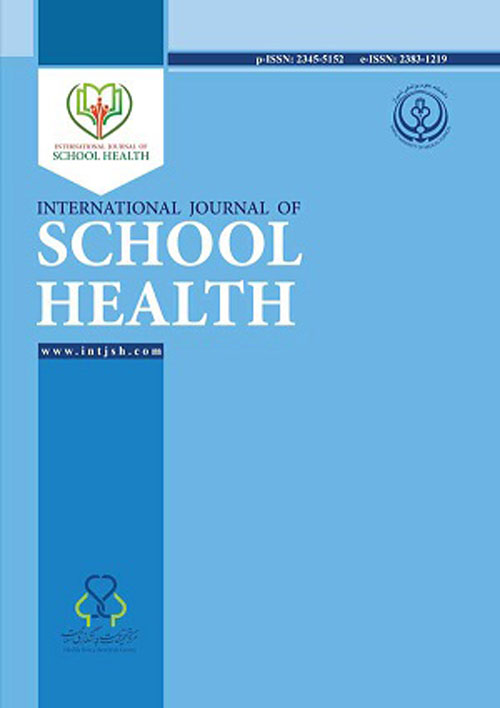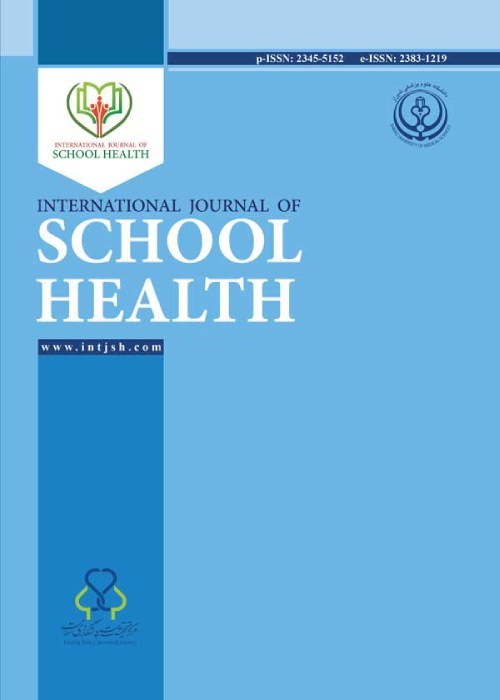فهرست مطالب

International Journal of School Health
Volume:2 Issue: 4, Autumn 2015
- تاریخ انتشار: 1394/06/17
- تعداد عناوین: 7
-
-
Page 1BackgroundOrganizational commitment is one of the most popular work attitudes, studied by the researchers. The high levels of employee commitment lead to several important outcomes at individual and organizational levels. Therefore, it is crucial to identify the factors that influence organizational commitment, with special reference to organizational health..ObjectivesThe purpose of this study is to examine the relationship between schools’ organizational health and teachers’ organizational commitment in Shiraz high schools..Patients andMethodsThe statistical population consisted of Shiraz secondary school male teachers. The multistage cluster random sampling method was used to select 250 subjects based on Kersji and Morgans’ table (1978). The organizational health inventory (OHI) was used to measure the health of secondary schools. An organizational commitment scale was then utilized to measure teachers’ organizational commitment. One-Sample T- test, Pearson correlation and multiple regression tests were used for data analysis..ResultsThe findings indicated that schools’ organizational health and its dimensions including institutional integrity, consideration, resource support, morale and academic emphasis were at moderate level, but the initiating structure and principal influence were at low level. Also, teacher’s commitment and its dimensions (emotional commitment and continuance commitment) were at moderate level and normative commitment was at high level. The results showed that the correlation between schools’ organizational health and teachers’ commitment was 0.64, and the correlation coefficients between teachers’ commitment and institutional integrity, initiating structure, consideration, principal influence, resource support, morale and academic emphasis were 0.56, 0.44, 0.42, 0.22, 0.26, 0.16 and 0.65, respectively. The results indicated that the correlation between schools’ organizational health and emotional commitment, continuance commitment, and normative commitment were 0.62, 0.32, and 0.66, respectively. Finally, five dimensions of school health- institutional integrity, initiating structure, resource support, morale and academic emphasis positively predicted teacher commitment..ConclusionsThe results of the present study are discussed with regard to developing the organizational health of schools and improving the organizational commitment of teachers. In other words, it can be concluded that teachers in a healthy school are committed to teaching and learning..Keywords: School, Health, Teachers
-
Page 2BackgroundVitamin D deficiency is a health problem in different countries. Vitamin D deficiency is an important health problem in both developed and developing countries. Recent reports on extra skeletal effects of vitamin D have led to increased interest in prevalence studies on states of deficiency/insufficiency of vitamin D..ObjectivesThe aim of this study was to determine the prevalence of vitamin D deficiency in children in city of Birjand, east of Iran..Patients andMethodsThis cross-sectional study was carried out in winter of 2012 and comprised 238 students of primary schools aged between 7 and 11 years. Sampling was done through randomized multiple stage method. The data were obtained using a questionnaire consisting of questions about weight, height and serum level 25 (OH) vitamin D. Serum level 25 (OH) D < 20 ng/mL was defined as deficient, level 20 - 30 ng/mL as insufficient and the level > 30 ng/mL as sufficient..ResultsOf the total number of 238 children surveyed, 110 (46.2%) were males and 128 (54.8%) females. Vitamin D levels in the subjects ranged from a minimum of 4.3 to a maximum of 63.1 ng/dL, with mean value of 15.4 ± 8.1 ng/dL. The deficient, insufficient and sufficient levels of vitamin D were found in 76.9%, 18.5%, and 4.6% of the students, respectively. Moreover, vitamin D deficiency was significantly higher in the females..ConclusionsIn regard to the protective role of vitamin D in preventing many chronic diseases, immediate intervention in the form of nutritional supplement is needed to overcome the high prevalence of vitamin D deficiency in children..Keywords: Prevalence_Vitamin D Deficiency_Children_Iran
-
Page 3BackgroundSchool climate has been linked with improved academic achievement, reduced behavioral problems and increased students’ health, especially mental health. So this concept is often a target of school improvement initiatives..ObjectivesThe goal of this study was to determine the effect of school climate on elementary students’ mental health..Patients andMethodsThe study comprised 300 grade 6 elementary school students in Shiraz, including 165 girls and 135 boys selected through multi-stages cluster random sampling. During a 45-min school session, the students completed a self-report questionnaires tapping school climate survey provided by Haynes and his colleagues in 2001 and also the general health questionnaire developed by Goldberg in 1978. All descriptive statistics, regression and confirmatory factor analyses, were performed using SPSS 19..ResultsSimultaneous multiple regression of school climate on students’ mental health showed that except for building appearance, other dimensions of school climate were predictors of elementary students’ mental health..ConclusionsAccording to our findings, it seems that school climate plays a critical role in student’s mental health. In fact caring for and supportive school environment can promote well-being and students’ mental health..Keywords: School, Climate, Mental Health
-
Page 4BackgroundHepatitis B virus (HBV) is considered as a serious public health concern. The health care workers and medical students are at a higher risk of HBV infection than the general population through occupational exposure. Vaccination against HBV is considered an effective means of infection prevention..ObjectivesThe aim of the present study was to determine anti-HBs titers among the medical students of Guilan University of Medical Sciences within the national HBV vaccination schedule..Patients andMethodsThis cross-sectional study comprised 209 medical students born between the years 1989 - 92 within a national vaccination gap of HBV and received HBV vaccine before age 18 years. The levels of anti-HBsAg ≥ 10 mIU/mL detected by ELISA were considered as protective against HBV..ResultsOf 209 students participated in this study, 11 (5.3%) showed no response to HBV vaccination. The protective titers of 10 - 1000 mIU/mL, and greater than 1000 mIU/mL of anti-HBs were found in 126 (60.2%) and 72 (34.5%) of students, respectively..ConclusionsThe periodic monitoring of anti-HBs titers in medical students is important because of their awareness about the risk factors associated with HBV infection..Keywords: Hepatitis B, Vaccines, Medical Student, Public Health
-
Page 5BackgroundDespite considerable research on violence and unintentional injuries among Jordanian students that focused primarily on those aged 13 - 15 years, very little attention has been paid to such injuries regarding 15 - 19 year-old students..ObjectivesThe purpose of this study was to estimate the prevalence of violence and unintentional injuries, among the Jordanian school students aged 15 - 19 years, and to compare the patterns of these behaviors between male and female students..Materials And MethodsThis descriptive-analytic cross-sectional study comprised 750 secondary school students and carried out on randomly selected eight comprehensive secondary schools (four schools for females and four schools for males) from the public educational directorate located in Amman. A modified Arabic version of the general school health survey questionnaire was used to measure violence-related behaviors and unintentional injuries..ResultsThe findings showed that 26.8% of students had been physically attacked. Overall, 43.3% of students were involved in a physical fight and 20.1% were bullied. Overall, 45.3% of students sustained serious injuries, of whom 31.2% were engaged in playing or training for sports, 35.6% were injured in a fall, and 60.3% hurt themselves by accident, with broken bone or dislocated joint presenting the most serious injuries. There was a difference between male and female students regarding physical attack, physical fight, and injuries..ConclusionsIt is necessary to implement an effective school health program including social and physical environments that promote safety and prevent injuries and violence..Keywords: Bulling, Physical Fight, Physical Attack, Secondary School Students, Unintentional Injuries, Violence
-
Page 6BackgroundExecutive functions are among abilities which school children require for learning in the future and deficit in executive functions in preschool children can continue into the older age and leads to serious problems in children in relation to doing their homework and other personal affairs..ObjectivesThe objective of the present study is to determine the validity, reliability and factor structure of the per-school version of behavioral rating inventory of executive functions (parent’s form) in Iranian children..Patients andMethodsThe present study comprised 592 children aged from 2 - 5 years selected from pre-school centers of the city of Isfahan in 2013 - 2014 using cluster random sampling method, with their parents answering the questions asked in this inventory. The correlation coefficient among items with a total score of factors, Cronbach’s alpha coefficient, confirmatory factor analysis, and the correlation coefficient among the subscales were used to measure the reliability and internal consistency of the inventory..ResultsConfirmatory factor analysis confirmed embedding items and the five-factor structure of the inventory including inhibition, shift, and emotional control, working memory and planning. In addition, Cronbach’s alpha coefficient was at satisfactory level for each of the factors and the total score of the scale (≥ 0.60)..ConclusionsIn general, it can be concluded that the behavior rating inventory of executive function (BRIEF) for preschool-aged children is a reliable and valid instrument for measuring executive functions of Iranian children, and can be used as a suitable means for psychological research and clinical situations..Keywords: Executive Function, Preschool, Factor Analysis
-
Page 7BackgroundAerobic exercise is an important component of pulmonary functions for obese adolescents. There are few studies on aerobic exercise and pulmonary function in obese adolescence..ObjectivesThe purpose of this study was to investigate the effect of selected aerobic exercise training on some pulmonary function of Iranian obese girls..Patients andMethodsForty-five, apparently obese adolescence, aged 14 - 15 years were randomly divided into three groups (15 subjects in each group) including rope skipping; jogging and control groups. Experimental groups participated in a twelve- week program (3 sessions a week, each session for 45 minutes) while control group had no plan of exercise. A spirometry test was taken 24 hours before and after the training protocol. Statistical analysis using the one-way analysis of variance was used (P < 0.05)..ResultsThe results suggested that all anthropometric characteristics of both experimental groups including weight, body mass index (BMI), percent body fat (PBF), waist-hip ratio (WHR) were significantly improved after exercise protocol, furthermore, ventilation capacity (VC), forced vital capacity (FVC), forced expiratory volume in the first second (FEV1) were significantly improved in experimental groups compared to control group (P < 0.001), while no significant difference was found between two experimental groups in ventilation functions (P > 0.001)..ConclusionsWe conclude that appropriate aerobic exercise can improve lung function in obese adolescence..Keywords: Jogging, Spirometry, Rope Skipping


